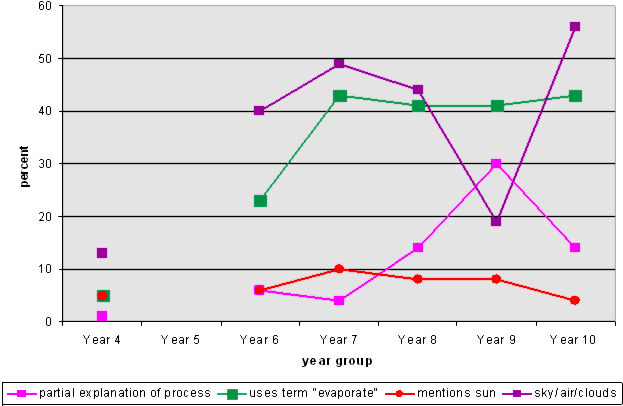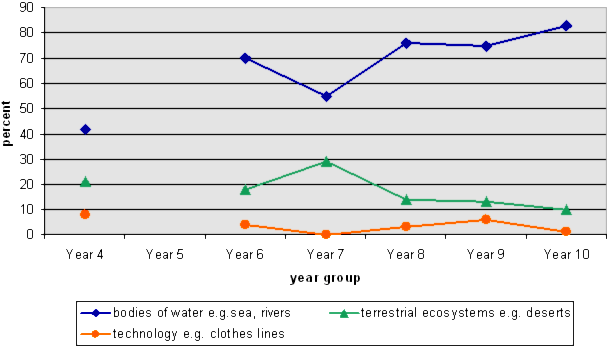Disappearing water
| Y4, 6, 8, 10 (07/2007) | ||
| a) |
goes into sky/air/clouds
|
very difficult (Y4) difficult (Y6) moderate (Y8 and Y10) |
| b) |
Any of:
|
3-4 correct – very difficult (Y4 and Y6) 3-4 correct – difficult (Y8 and Y10) or 1-2 correct – very easy (all levels) |
| c) | goes into sky/air/clouds |
very difficult (Y4) moderate (Y6, Y8, and Y10) |
| d) |
a body of liquid water, e.g., river, lake, sea or places on land, e.g., a desert or technology, e.g., clothes line, drier |
easy (Y4) very easy (Y6, Y8, and Y10) |
| e) | sun | very easy (all levels) |
Results are based on a trial set of 655 students from Years 4-10, in July 2007. The difficulty levels are based on student data from Year 4 (99 students), Year 6 (115 students), Year 8 (128 students), and Year 10 (183 students).
This resource was trialled with 655 students from Years 4-10, so the data collected provides a good indication of how students' ideas change over time.
NOTE: Year 5 was a particularly small group of just 15 students from 1 school who performed better on some questions than older students, probably indicating a school effect.
Students' responses to the questions uncovered the same misconceptions and partially correct responses that have been identified in international research (Salient points from the literature about understanding the water cycle). However, as you would expect, the number of students holding these misconceptions generally lessened with age. The information below compares responses of the trial students in different Year cohorts.
QUESTION A
Student responses: Where does the water go?

NOTE 1: There is no line linking the Y4 responses to the others because we did not include Y5 data.
NOTE 2: Some students' responses included more than one category. For example, they may have used the term "evaporation" and identified the sky as where the water went.
The first graph shows the development of science understanding, and the use of scientific language. Year 4 students found this a particularly difficult question to answer. This could be because at Level 2 there is a focus on observing what is happening. Students need these experiences before they can start to develop theories about why it happens.
Student misconceptions: Where does the water go?

NOTE: There is no line linking the Y4 responses to the others because we did not include Y5 data.
The second graph shows common misconceptions. In the trial the most prevalent was that the water disappeared into the ground. This dropped markedly between Year 4 and 6, but there were still about 15% at Year 10 who gave this response. These students may not hold the concept that water evaporates, becoming a gas. They are relying on observation only, when they have seen clothes dripping.
Research shows that the most naïve response to the process of evaporation is that the water just disappears, or ceases to exist (go to Salient points from the literature about understanding the water cycle). Very few (less than 5%) of the trial students, at any level, gave this response.

NOTE 1: There is no line linking the Y4 responses to the others because we did not include Y5 data.
NOTE 2: Some students' responses included more than one category.
The most common factor identified at all years except Year 4 was the sun. Technology such as driers, washing lines, and hot water cupboards, was the next most common, followed by the wind, except at Year 10 when technology and wind were reversed. It is interesting that older students mentioned technology less often than younger students. It may be that they recognise that some technology replicates natural factors.
Very few students at any year identified low humidity (and none till Year 7). An example is:
- Room humidity
Of those who did, not all actually used the term humidity, but they indicated an understanding of the concept, for example:
- No rain (dry).
- Dry weather
Students got better at giving multiple answers. At Year 4 about half gave only 1 factor and less than 5% gave more than 2. By Year 10 about 15% identified 1 factor, and about a quarter identified more than 2. Only 3 students altogether (1 Year 8 and 2 Year 10s) identified 4 factors.
No students mentioned the type of fabric, or the size/surface area of the washing, although occasionally a student gave an indication that it should be spread out (these responses were coded under technological responses). They therefore focused only on the surrounding conditions, not the properties of the washing itself.
The following graphs show how, as students get older, they are more likely to incorporate science ideas into their explanations, and less likely to include misconceptions. Student responses: Where did the water go?

NOTE 1: There is no line linking the Y4 responses to the others because we did not include Y5 data.
NOTE 2: Some students' responses included several categories. For example, they may have used the term "evaporation" and identified the sky as where the water went – this would also fall into the category of a partial explanation.
The patterns do not always show a consistent upwards trend. This is partly due to students incorporating different aspects in their explanations. For example, at Year 9 the students were less likely to say where the water went, but they were more likely than Year 8 and Year 10 students to attempt to explain the process of evaporation. One clear pattern, though, is the jump in understanding from Year 4 to Year 6, which is consistent with when they are likely to first be meeting the science ideas at school.
Very few students provided a full explanation of the process involved, i.e., a description of the changes in state. (This is not shown on the graph because it was such a small percentage.) By Year 10 there were still only about 60% of students giving a partial or full explanation of the process. Common responses were that the water had "evaporated" or "evaporated into the air", without providing an explanation of what this meant. This does not mean that the students do not know the process, so it is worth questioning students to check their level of understanding.

NOTE: There is no line linking the Y4 responses to the others because we did not include Y5 data.
The most common naïve explanation was that the water went into the ground. This, and the explanation that the water had gone down the pipes or drains, may be based on their experiences, e.g., seeing the water going into the drain at the school or community pools. These students may not yet have the concept that water evaporates, becoming a gas. (Some did mention both drains and evaporation). The graphs show that, as students learn about evaporation they are less likely to make these responses.

NOTE 1: There is no line linking the Y4 responses to the others because we did not include Y5 data.
NOTE 2: Some students' responses included more than one category.
Most students were able to describe another example of where evaporation could occur, and they were most likely to identify a body of water. Few discussed another form of water such as ice, which is not surprising as, in most cases, it would have to change state twice. (Ice and snow will sublimate (change directly from a solid to a gas) if conditions are right.)
A few identified the sun. This could be due to a) misreading the question (interpreting it as what dries up water), or b) focusing on the heat aspect of the sun without thinking about whether there would be water present on the sun.
QUESTION E
Where does the heat come from?
Between 80% and 90% of students across all years knew that the sun was a factor. Some students also identified other heat sources. They were most likely to say the sun and something else at Year 8.
- The sun or fire, something which produces heat
- The sun and the water's surroundings

Questions a) and c) revealed some evidence of developing science language. Students at Year 4 rarely included the term "evaporation" in their responses, but by Year 10 it appeared in about 2/3 of students' answers. Between Years 6 and 7 there was a jump from approximately 1/4 to about 1/2, suggesting that many students are being exposed to the science language at these years, and incorporating it into their explanations.
However, very few students at any level made specific mention of the process this involves, by describing a change of state. Because the question did not ask students to go into any detail, this is not indicative that they cannot do it. However, teachers may want to add the question, "How does this happen?" to check that students are not just using the term, but also understand what the process of evaporation entails.
- a saucer of water on the window sill;
- a pot boiling dry;
- a puddle drying up.
Before students can understand evaporation they need to realise that water can exist as a gas. This is a difficult concept because water vapour is invisible and therefore cannot be observed. However, they can see steam (which is when some of the water vapour is turning back to liquid water), and this can be useful for getting across the idea that the water can be in little "bits". Get them to imagine that some of the bits are so small they cannot be seen (a beginning understanding of particle theory). Exploring examples of condensation can also help, e.g. breathing on a mirror.
- Can you see the water vapour in your breath as it comes out of your mouth?
- Where has the water on the mirror come from?
- When can we "see" our breath? (on cold mornings). Why is it visible?
Students who identify only one factor in drying [b)]
Encourage students to think about multiple factors. Follow up with planning and carrying out fair tests to investigate the factors they suggest.
Extend students who already identify multiple factors to consider air humidity.
- What do we mean when we say, "The weather is humid today"?
- Predict, with reasons, whether washing will dry more or less quickly when the weather is humid.
Changes of state, is about finding the features of a science test.
- Ministry of Education (1998). Making better sense of the material world. Wellington: Learning Media.
- Ministry of Education (2001). Building Science Concepts, Book 15. Where's the water? Wellington: Learning Media.
- Ministry of Education (2003).Building Science Concepts, Book 31. Water and weather. Wellington: Learning Media.
- Dissolving sugar and salt
- Humidity
- Puddles on plastic
- Water facts
- Evaporation, condensation or neither?
- Effect of surface area on evaporation rate
- Is it evaporation or condensation?
- Where did the water go?
- Where did the water go? II
- The water cycle
- Investigating the water cycle
- The disappearing puddle
- Evaporating water

